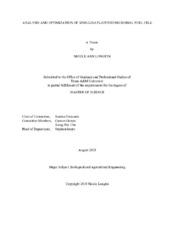ANALYSIS AND OPTIMIZATION OF SPIRULINA PLATENSIS MICROBIAL FUEL CELL
Abstract
In the search for renewable energy alternatives to traditional energy sources, microbial fuel cells are emerging as a potential solution. MFCs can produce electricity while simultaneously treating wastewater or powering a biosensor. The algae Spirulina platensis was used due to its high nutritional content and ease of cultivation. A unique configuration that allows utilizing O2 generated via photosynthesis at the cathode (targeting fuel cell operation in an oxygen-limited environment) for an algae-based microbial fuel cell was designed, developed, and tested for 21 days. The results showed the highest performance on day seven during the exponential growth phase, with an open circuit voltage of 227.7 ± 0.08 mV.
The highest power density was obtained when the fuel cells were connected in parallel, at 59.8 ± 7.96 mW/cm2. Electrochemical Impedance studies helped to characterize the bonding events of the biofilm on the anode. It was determined that the equivalent circuitry of the fuel cell most closely resembled a Randles circuit. The biofilm growth on the anode increased the charge transfer resistance in the nine days measured. It was determined that for optimal output of the algal microbial fuel cell, fresh media should be added on the 14th day to keep Spirulina platensis in the exponential growth phase. If multiple fuel cells are run, they should be connected in series; however, the voltage from each needs to be equivalent to avoid any voltage reversal.
Subject
Microbial fuel cellSpirulina platensis
Microalgae
Algae fuel cell
Electrochemical characterization
Citation
Longtin, Nicole Ann (2019). ANALYSIS AND OPTIMIZATION OF SPIRULINA PLATENSIS MICROBIAL FUEL CELL. Master's thesis, Texas A&M University. Available electronically from https : / /hdl .handle .net /1969 .1 /186525.


